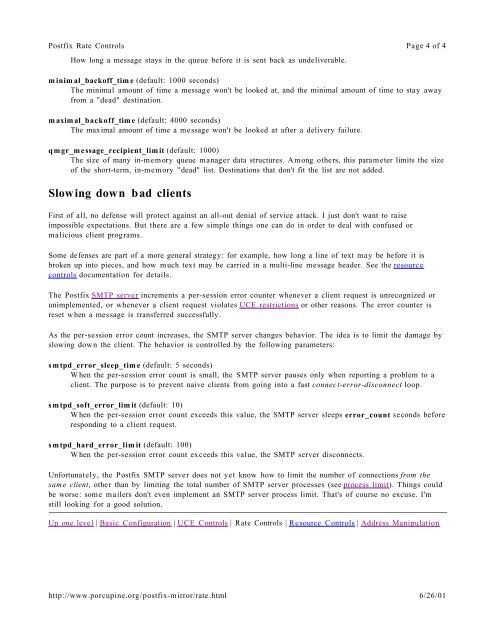Postfix Overview - Introduction - SCN Research
Postfix Overview - Introduction - SCN Research
Postfix Overview - Introduction - SCN Research
Create successful ePaper yourself
Turn your PDF publications into a flip-book with our unique Google optimized e-Paper software.
<strong>Postfix</strong> Rate Controls<br />
How long a message stays in the queue before it is sent back as undeliverable.<br />
Page 4 of 4<br />
minimal_backoff_time (default: 1000 seconds)<br />
The minimal amount of time a message won't be looked at, and the minimal amount of time to stay away<br />
from a "dead" destination.<br />
maximal_backoff_time (default: 4000 seconds)<br />
The maximal amount of time a message won't be looked at after a delivery failure.<br />
qmgr_message_recipient_limit (default: 1000)<br />
The size of many in-memory queue manager data structures. Among others, this parameter limits the size<br />
of the short-term, in-memory "dead" list. Destinations that don't fit the list are not added.<br />
Slowing down bad clients<br />
First of all, no defense will protect against an all-out denial of service attack. I just don't want to raise<br />
impossible expectations. But there are a few simple things one can do in order to deal with confused or<br />
malicious client programs.<br />
Some defenses are part of a more general strategy: for example, how long a line of text may be before it is<br />
broken up into pieces, and how much text may be carried in a multi-line message header. See the resource<br />
controls documentation for details.<br />
The <strong>Postfix</strong> SMTP server increments a per-session error counter whenever a client request is unrecognized or<br />
unimplemented, or whenever a client request violates UCE restrictions or other reasons. The error counter is<br />
reset when a message is transferred successfully.<br />
As the per-session error count increases, the SMTP server changes behavior. The idea is to limit the damage by<br />
slowing down the client. The behavior is controlled by the following parameters:<br />
smtpd_error_sleep_time (default: 5 seconds)<br />
When the per-session error count is small, the SMTP server pauses only when reporting a problem to a<br />
client. The purpose is to prevent naive clients from going into a fast connect-error-disconnect loop.<br />
smtpd_soft_error_limit (default: 10)<br />
When the per-session error count exceeds this value, the SMTP server sleeps error_count seconds before<br />
responding to a client request.<br />
smtpd_hard_error_limit (default: 100)<br />
When the per-session error count exceeds this value, the SMTP server disconnects.<br />
Unfortunately, the <strong>Postfix</strong> SMTP server does not yet know how to limit the number of connections from the<br />
same client, other than by limiting the total number of SMTP server processes (see process limit). Things could<br />
be worse: some mailers don't even implement an SMTP server process limit. That's of course no excuse. I'm<br />
still looking for a good solution.<br />
Up one level | Basic Configuration | UCE Controls | Rate Controls | Resource Controls | Address Manipulation<br />
http://www.porcupine.org/postfix-mirror/rate.html<br />
6/26/01
















